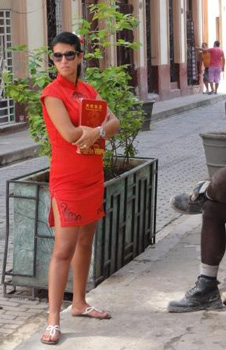The Fading Splendor of Havana’s Chinatown

Daisy Valera
HAVANA TIMES — I had my first contact with Chinese culture thanks to a childhood friend, Javier. He was a Chinese kid who would invite kids around the neighborhood to his house and make his grandfather read old newspapers. What he read was in Chinese, of course, which is what made the experience so much fun for us.
The other early contact with this culture I had was of the culinary kind and it is still almost a mystery to me. I can’t imagine how it is I managed to come across spring rolls and Chinese dumplings during the harsh years of the Special Period in the ‘90s.

My memories of Sancti Spiritus’ Yangtse and Shanghai restaurants encouraged me to visit Havana’s Chinatown. The first time I walked through the immense gate, designed in the style of the Minh dynasty, was in 2005. I recall I ended up eating spaghetti there. The price of a modest fried rice was too high for my university student pockets.
In recent years, I have visited this, what was once the largest and most prosperous Chinatown in Latin America, dozens of times. Today, it is difficult to find any vestiges of its former splendor.
The most distinctive aspect of today’s Chinatown is quite possibly the young Cuban women (without slanted eyes) who wear tight-fitting imitations of traditional Chinese dresses and stalk passersby to inform them of different menu offers.
Not many of the businesses established by the Chinese community in Cuba remain. One no longer finds fried-snack kiosks, exotic ice-cream vendors, fruits wrapped up in cellophane or dry cleaners. The taverns of old have retreated to give way to restaurants stuffed with traditional Cuban or Italian food.

The Lion Dance, the sound of a bugle and a handful of martial arts practioners sum up what little remains of Chinese culture on the island. We can no longer stand in awe, as did renowned Cuban novelist Alejo Carpentier, before the acrobatic feats and operas staged at what he called “the yellow town.”
Of the thousands of Chinese immigrants who once settled in Cuba, less than 400 elders remain, and a mere 11 Chinese associations (of the 36 that existed in 1959), are still in operation.

The main exodus of this community took place following the nationalization of their businesses by the Cuban State in 1968. The island’s Chinese fled the Cuban revolution in the same way they had fled Mao’s – they took their music and their charade elsewhere.
Every June, Cuba celebrates the arrival of the first Chinese immigrants to Havana’s port. The 167th anniversary of this event took place on June 3rd. The comprehensive restoration plan being implemented in Old Havana by the Office of the Historian seeks to revitalize Chinese culture and repair the architectural heritage of Chinatown, but these efforts continue to lack a community with links other than hereditary ones.






Not kosher (reference Vol. 1 Talmud “Kashroot”. Only mammals with split-hoof (not horse) and chewing cud (not swine) may be consumed , and only after kosher rendering process. I am not Jewish, but grew up in a Jewish town (Monterey Park , CA , USA) during the 1950’s and 60’s. I can talk about Kashroot all day long thanks to Martin Solomon.
I worked for about 30 years in and around Boston’s Chinatown and have long been a great fan of authentic Chinese cooking ( but decidedly NOT Chinese tripe or tripe soup ) .
Once out in the suburbs and away from a Chinese customer base , the food becomes Americanized , over-salted, over -fried and with ingredients not found in traditional Chinese cooking .
When in Negril (Jamaica ) I ate at a so-called Chinese restaurant and in the absence of Chinese vegetables like Chinese broccoli ,bean sprouts, bamboo shoots , black mushrooms the Jamaican chef had to substitute carrots, celery and other off-tasting things that just cannot work in particular Chinese dishes .
It is the nature of restaurants to adapt to local tastes and indeed they must do so to survive in many cases and forego the luxury of being authentic.
Here where I live in Florida, it is about a 15 mile drive to the nearest authentic Chinese restaurant that serves dim-sum, roast duck and rice porridge (congee) .
A small local Chinese restaurant I just tried made my Beef Chow Hor Foon with celery, carrots and bamboo shoots, none of which should have been in this simple dish.
IMO-the Chinese have the best and most extensive cuisine in the world .
I remember reading a story in the Wall Street journal many, many years ago about a restaurant in China which only served RAT ( raton) in various ways.
The reviewer said to skip the German Braised Rat because it had the texture of greasy chewing gum but highly recommended other rat preparations more attuned to the Western palate .
I wonder if it’s kosher to serve rat with cheese?
OK
Lunchtime
gotta go nibble on some tiny feet.
IMO
Nice story Daisy! I wish I had seen Chinatown in its past glory. Do you know if the little restaurant by the entrance gate on Dragones is still in business? I loved the food there, even though it was not Chinese.
Jenny
I do agree with you that Havana’s Chinatown is a shadow of it’s former self. Even in the few years I have been visiting the number of restaurants has dwindled.
But every time I am in Havana I still go to Tien Tan it is an absolute must for me.
The food is still as good as the first time I ate there.